The stinging sensation has a vice-like grip on my entire body. A million fleeting thoughts and cries of agony pulse through my brain and course about my trembling core. Looking up to a bluebird Northern Rivers sky, I attempt to smother the incessant discomfort: the ice has well and truly knocked everything out of me. Closing my eyes and taking long, drawn-out breaths, I turn every measure of my attention internally. A distant voice tells me we’re 30 seconds down — there are another 90 seconds of brutal frigidity left to come.
How many videos of people dipping into ice baths have you seen in the last little while? And on how many occasions have you heard or read the words ‘breathing techniques?’ There’s little doubt both have been doing the rounds in social media over the last few years, perhaps spurred on by the logic-defying feats of the modern-day father of cold immersion, Wim Hof. A lunatic or physiological outlier? Opinions are divided on the Dutchman and what he’s achieved. He’s certainly a one-of-a-kind.
One of Hof’s Australian disciples is Benny Berry, who runs a Breath & Ice workshop in Byron Bay. He’s a former lifeguard, underground rescuer and firefighter in a fly in/fly out capacity. “These roles have high pressure and stress written all over them,” says Berry. “You’re preserving and sustaining human life and often it’s confronting – but to be proficient, you learn to shut it all out.”
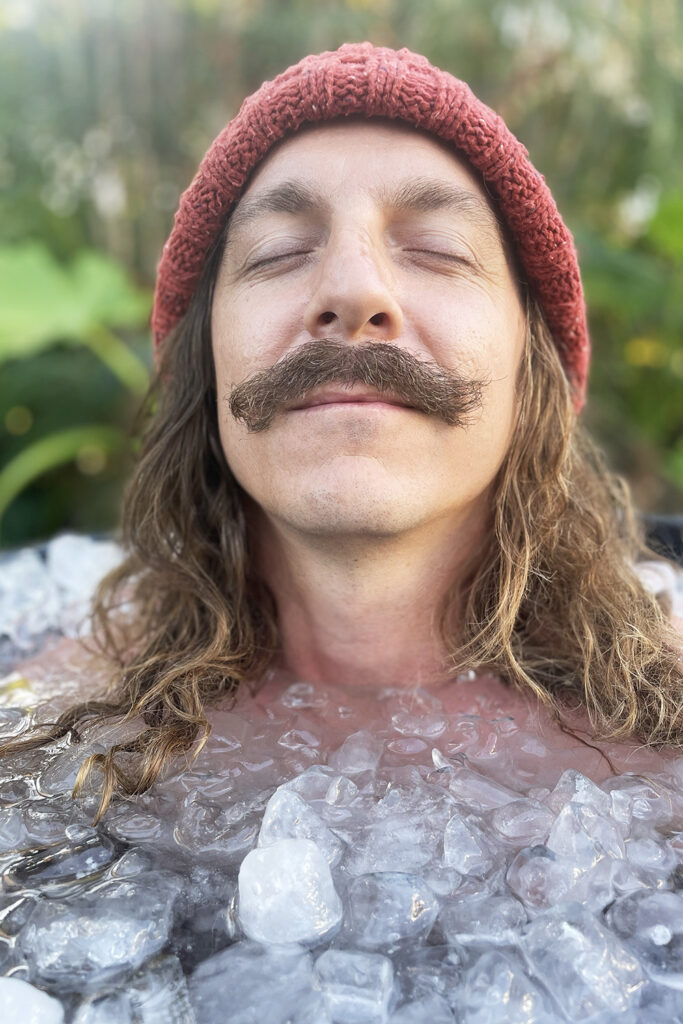
A series of surfing injuries compounded by a work-related incident that sidelined him with agonising pain and a failed surgery later, Berry found himself couch-bound and in a dark place. “The pain was taking over my life,” he recalls.
It was at this point that a chance recommendation completely changed the trajectory of his life. “A friend suggested I give the Wim Hof breathing technique a go,” says Berry. “So, curious, my wife helped me onto our living room floor and after this one session I was able to get up by myself – she couldn’t believe it! That is what got me fully out of pain”.
Although physically better, some anxiety and stresses were still there, enough to steer Berry out of a stable, high-paying career and have him devote himself to becoming a fully qualified and practising Wim Hof facilitator. The benefits were simply too profound to ignore. Reflecting on his life choice, he says, “With the Wim Hof technique, I came for the pain relief. And after getting it, I could have easily left. But I ended up staying for the emotional growth: the way it calms down the nervous system is virtually instantaneous and I knew it was something I had to share with others.”
As a person who lives with anxiety, I’ve been keen to delve into this breathing practice and see if cracking a smile while relaxing between chunks of ice is as natural as it looks. I attend one of Benny’s workshops in Byron on a sun-drenched winter’s morning. Along with about 30 other participants, we spread out and lie down, readying ourselves for what’s to come. The Wim Hof breathing method is characterised by 30 fast and full breaths in and out. On the final outward breath you hold your breath for a period of one to three minutes. The final part involves a lung-busting breath in and hold for 15 seconds, followed by a long exhale – this is one round of a usual six. As you’d expect, this style of breathing is astonishingly laborious, as we work through the rounds. It doesn’t take long before I experience bouts of tingling and light-headedness: a noticeable pinch of elation and positivity begins to wash over me. But how so?

The ins and outs
I’m attempting to recalibrate my breathing as Berry explains the methodology behind the technique. “There are four pillars of this technique, and three of them are closely connected,” he says. “The first is oxygenating the blood; healthy blood needs high levels of oxygen and is essential for recovery. The second is decreasing carbon dioxide, which sends our body into a state of alkalinity, associated with deep rest and healing. The third is spiking a cytokine called Interleukin 10, a protein and the body’s most potent anti-inflammatory. Our bodies have become conditioned to love inflammation through diet and lifestyle choices. Because of this, we tend not to activate that crucial Interleukin 10 as much as we could.”
It’s an undeniably potent trifecta and a great way to remedy stressed shallow breathing, with the anti-inflammatory properties of interleukin 10 being the cherry on top, Berry says.
“Together, these three facets create an environment in our body conducive to repair — therefore, there are great benefits for acute injuries right through to chronic disease. With the latter, you can often feel some form of relief straight away.”
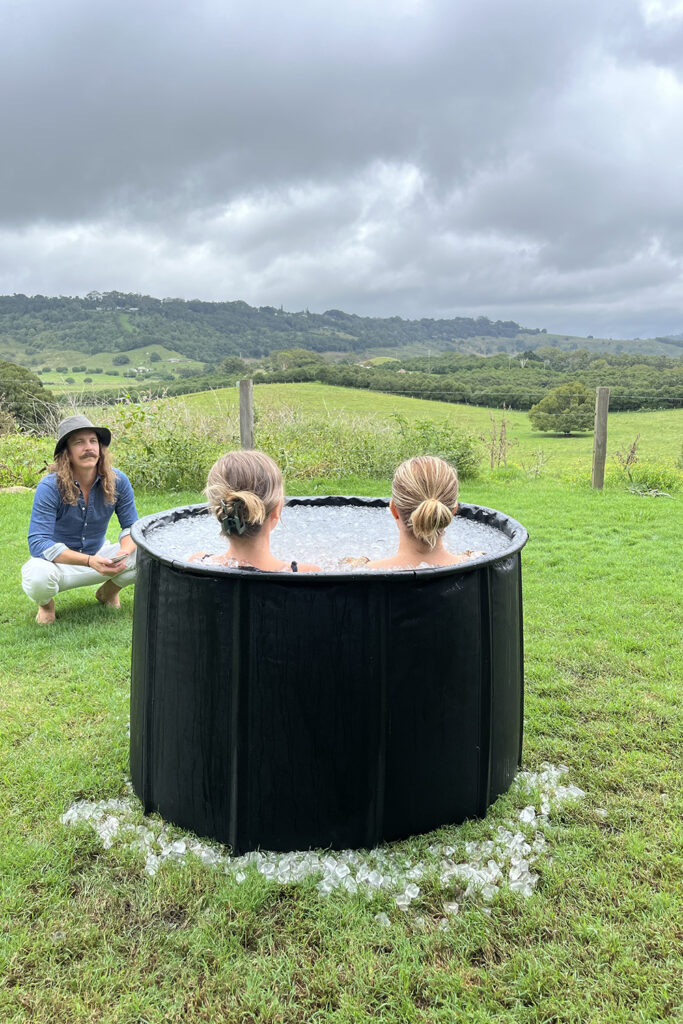
And the fourth facet? “The final part is the blood doping aspect,” he says. “When you perform the breath holds, you put yourself into a state of hypoxia; this is where your body can’t access oxygen – or so your body is led to believe. It’s a trick because your red blood cells do, in fact, have plenty of oxygen in them but not enough carbon dioxide, which is needed in the gas exchange to release them.” When this happens, the body secretes a hormone called Erythropoietin (EPO), a precursor for creating red blood cells. It’s the same principle behind altitude training. It was, of course, made famous by a handful of Tour de France riders who were illegally injecting themselves with it throughout the ’90s and ’00s. But now, because we understand more, athletes can do regular training and supplement it with breathwork – without the necessity of altitude and illegal doping, adds Berry. And while significant research suggests that EPO has beneficial effects in treating autoimmune disease and organ-specific autoimmune nervous system disorders, in sport it has gained notoriety.
Whether you’re a cycling fan or not, you can appreciate the degree to which EPO enhances strength and endurance when you reflect on the staggering seven yellow jerseys one fellow wracked up on Le Tour, one of the world’s most arduous sporting events, in the late ’90s. It’s safe to say that without EPO, you’d probably have never heard the name, Lance Armstrong.
“Ancient and modern-day eastern cultures don’t need proof or data: they practise it knowing it makes a difference, and that’s all they need”
Should we all be doing this sort of thing habitually, like a morning coffee or evening stretch, then? “Unfortunately, it’s not quite that straightforward,” warns Berry. “Breathwork and related principles in the western world are totally in their infancy. However, ancient and modern-day eastern cultures don’t need proof or data: they practise it
knowing it makes a difference, and that’s all they need. Things for us in the West are different; we’re so caught up on having proof and solid evidence; otherwise, we think it’s fake
or exaggerated”.
Towards the end of the session, I find myself making a mental shift. I feel inexplicably emotional and have wandering thoughts of my family and friends living back in the UK. Involuntary tremors jolt me while a wave of lucidity washes over me, dissipating the white noise my overactive brain typically has on repeat. “The first three rounds are where the physiological benefits occur. When you go beyond these, you start to go into the intrinsic aspects of the mental, the emotional and the spiritual,” says Berry. “If done properly, people normally go into a flow state where stresses and overthinking don’t exist – the essence of living. The mental and emotional benefits are as profound as the physical.”
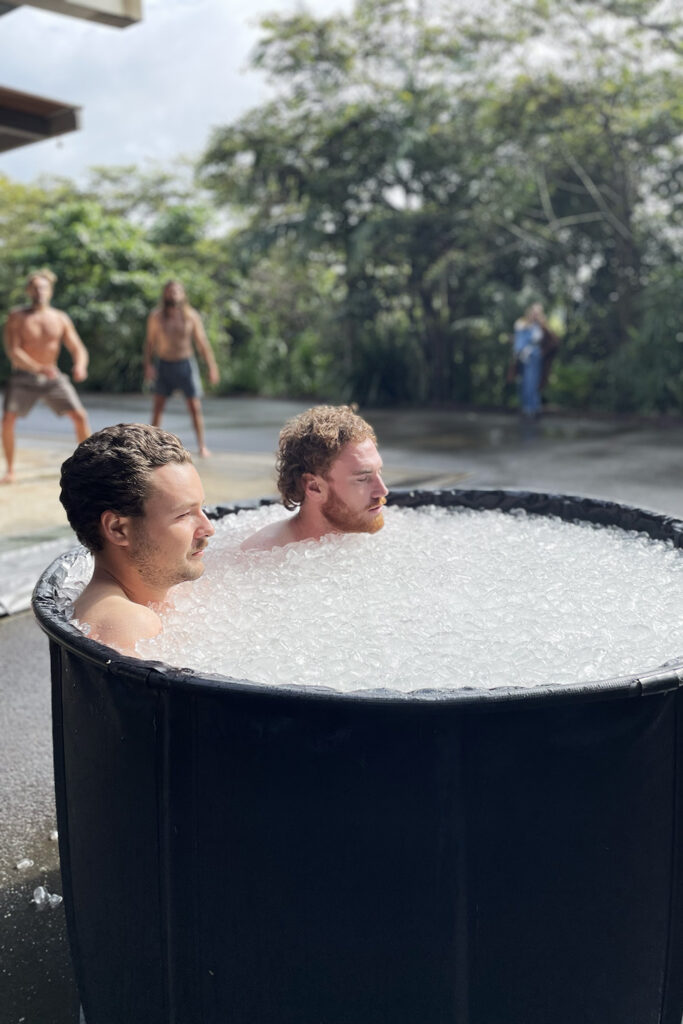
The adage that you should listen to your heart over your head was right all along, Berry reckons. “When we do the breath work, our brain activity generally shifts from the rear towards the front of our brain,” he says. “This part is heavily associated with feeling: your emotional body and connection to self and others. Every day we have thousands of thoughts, so the easiest way to put it is that breathwork allows you to get your thinking side out of the way – and it might sound like a cliché – but this allows you to hear your ‘heart’ and feel what is right and what is wrong.”
Taking the plunge
The breathing session draws to a close and there are a lot of semi-comatosed-looking smiles around the room. But we don’t have long to bask in this newfound serenity as an ice bath finale looms.
The ice bags are empty and the hose pipe is switched off. Beside two other hardy souls, I opt to be in the first trio to take on the cold. There is no sugar-coating this: it’s hard, aggressive and doesn’t let up for at least a minute. From there it becomes marginally more manageable as the body’s response – shivering thermogenesis – alleviates the maddening distress. But let’s be honest here: the challenge is real.
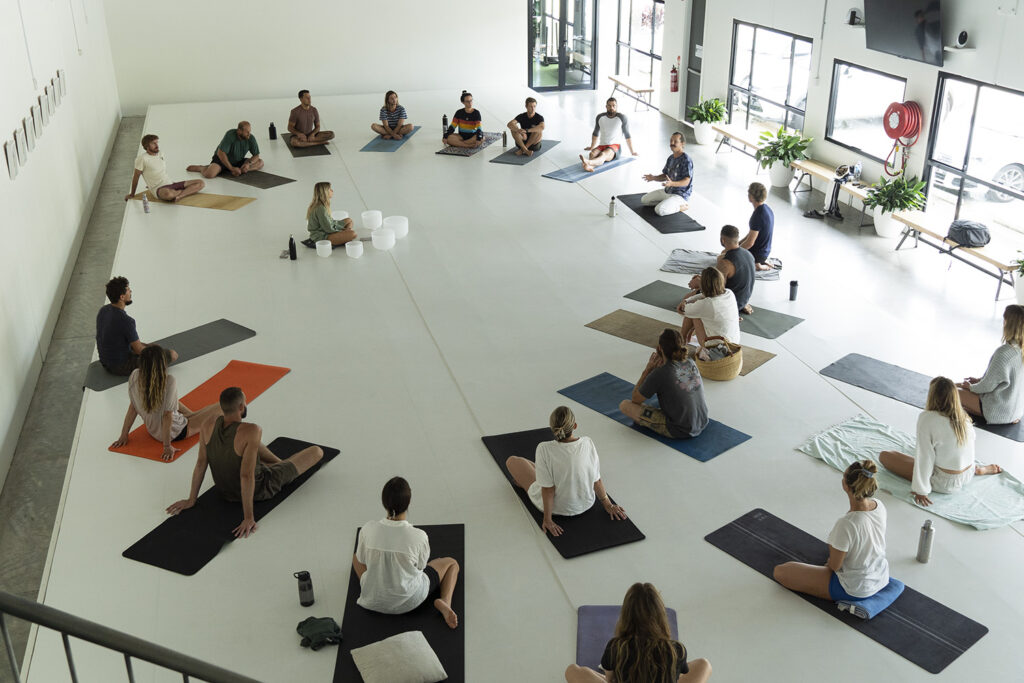
Berry tells me, “The ice is much stronger on the mental and wellbeing side of things. It gives you a sense of conquering something and a big hit of exhilaration.”
And just like that, the two minutes are up. With a final head dip, I scramble out and begin warming myself back up.
“The thing with the ice bath is half the benefits occur in the ice and the other half happens when you get out and allow your body to come back up to homeostasis,” Berry explains with a smile. “That five-to-10-minute period is where all the strength and immunity building occurs. They’re great, but you can imagine an alpine situation where people bathe in running streams that are 2°. When they get out, that warming back up process takes much longer and requires more of you.”
“I find myself abstaining from my afternoon coffee, experiencing fewer wandering thoughts and falling asleep faster”
Looking back at a video of myself in the ice, I can see flickers of a smile behind a stony, grimace-masking facade. The absurdity of the cold, coupled with the overarching knowledge this is healthy for me, I find quite funny. Now, I’m much closer to understanding the countless grins I’ve witnessed from strangers as they dip into frigid waters on social-media feeds. But it begs the question: how many people have the space, money or time to invest in a fully-fledged ice bath?
“Don’t get me wrong, ice baths are epic and doing them when you can is great,” says Berry. “That said, they’re not completely necessary. You just have to get cold, and a cold shower is perfect for this. You’ve got to get out of your comfort zone and if you can spare 15 minutes for the three rounds of breathwork and then a cold shower, you can successfully set foot in the Wim Hof Method. You cannot get any easier than that!”
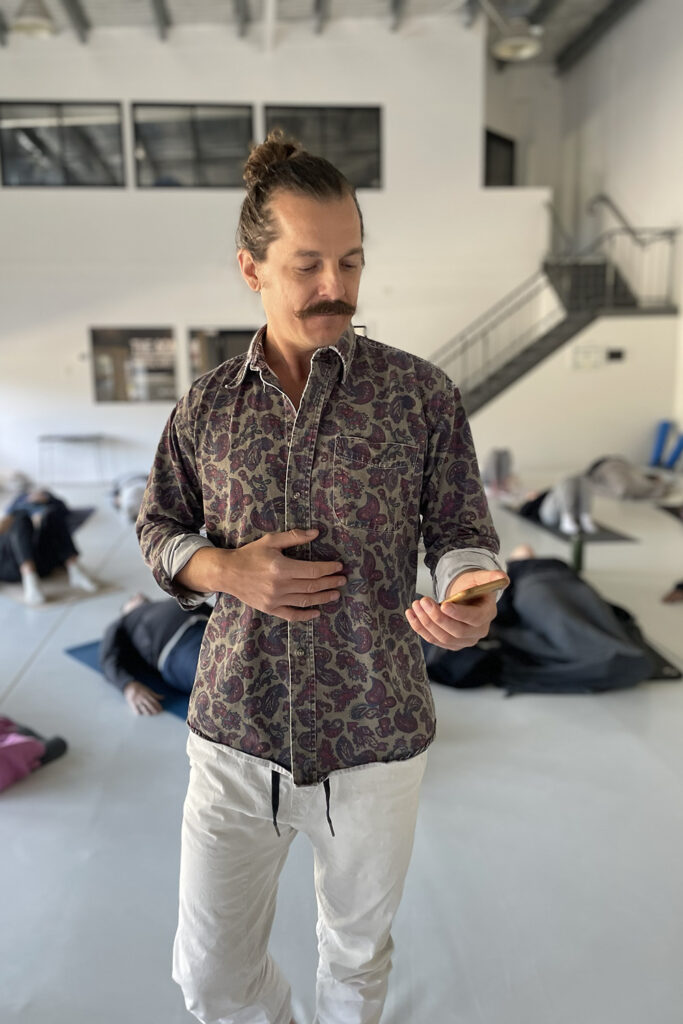
For several days after the session, I find myself abstaining from my afternoon coffee, experiencing fewer wandering thoughts and falling asleep faster. It’s no surprise to me when Berry gifts free spots in his workshop to those affected by the catastrophic floods in the Northern Rivers and to those who have lent a hand in the mass clean-up. And although the gratitude he witnesses first-hand is powerful, what, I wonder, is his reward?
He laughs. “Sometimes I feel there is more in this for me than for the people I facilitate. I enjoyed my professional career but didn’t have a passion for it. For me, there’s nothing more rewarding than having people tell me what a massively positive effect my teaching techniques have had on their lives. It doesn’t get any more satisfying.”
The Ice Man Is Born
In this exclusive extract from his new book, The Wim Hof Method, the Dutchman recalls the first time he ventured into icy water, an experience that changed the course of his life.
On a quiet Sunday morning in the wintertime, I was in Beatrix Park and I saw this thin layer of ice on the water. I felt an attraction to it that I couldn’t explain. I looked around and there was nobody else in sight. I could undress myself and just go naked into the cold water. I remember very clearly that I wasn’t bothered by the cold at all, just curious. That curiosity was stronger than the temperature of the water. Can you imagine that? And that cold water had an unexpected effect on my body. I felt great. Everybody always said it was crazy to go into cold water. You could die, they said. That’s what we had been conditioned to believe, but all of that vanished in this moment.
I wasn’t in the water for too long, maybe a minute-and-a-half, but long enough to feel the connection, borne to my consciousness, within. Now we can understand that the strength of my curiosity was a demonstration of the human mind’s immense power. But sadly, mankind as a whole has lost its connection to this power because we rarely, if ever, venture out into the elements anymore. We stay snugged-up in our cosy, heated homes, safe from the environmental stressors that enable this power to rise within us. Thus, our minds are not able to transcend the impact of extreme forces on our bodies or to accept the truth of mind over matter. I know it’s the truth and have dedicated most of my life to demonstrating it.
It all began in earnest right there. It was the origin point of my entire quest. I returned to the water a few days later and did the same thing with the same results. I began to notice that I would involuntarily gasp each time I immersed myself. And when, at a certain moment, I did twenty-five deep breaths, it made my body tingle like crazy, like electricity. Going into the water makes you breathe deeper and more consciously. The carbon dioxide goes out, and the muscles begin to contract. It’s basic physiology. But it’s also that electricity, the autonomic nervous system, at work. Over time, a routine took shape. It was organic and progressive and this physical experience of the cold and following my gut led me to a true personal discovery of my own mind-body connection. I was only seventeen, and I felt alive and excited. With practice, I’d be so fully charged by my breathing practice that the trigger to breathe wasn’t really there. I got to where I could go for over five minutes without taking a breath. I did this all winter long, for twenty-five years. Over that time, I learned how to consciously control my body. I remember sitting outside one freezing night wearing nothing but shorts and feeling great about it. I knew that I was on to something. And I was. The Iceman had been born.
The Wim Hof Method: Activate Your Potential, Transcend Your Limits is out now.
















